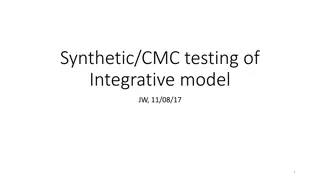Understanding Economic Development: Tools and Models for Analysis
Exploring conceptual tools for studying economic development, this seminar delves into key macroeconomic models such as Keynesian, export-base, and input-output models. The simplicity and implications of a Keynesian model, including the role of savings, consumption, investments, and trade, are discussed to understand how different factors impact economic equilibrium and income generation. The multiplier effect of exports and other external influences is also highlighted, emphasizing the interplay between consumption, imports, and economic growth.
- Economic development
- Macroeconomic models
- Keynesian economics
- Input-output analysis
- Economic equilibrium
Download Presentation

Please find below an Image/Link to download the presentation.
The content on the website is provided AS IS for your information and personal use only. It may not be sold, licensed, or shared on other websites without obtaining consent from the author. Download presentation by click this link. If you encounter any issues during the download, it is possible that the publisher has removed the file from their server.
E N D
Presentation Transcript
PUBLIC FINANCE SEMINAR PUBLIC FINANCE SEMINAR SPRING 2021, PROFESSOR YINGER SPRING 2021, PROFESSOR YINGER Conceptual Tools for Studying Conceptual Tools for Studying Economic Development Economic Development
Conceptual Tools for Studying Economic Development Conceptual Tools for Studying Economic Development Class Outline Class Outline Macroeconomic Models Simple Keynesian Models Economic Base Models Input-Output Models Agglomeration Economies Conceptual Frames
Conceptual Tools for Studying Economic Development Conceptual Tools for Studying Economic Development Macroeconomic Models Macroeconomic Models Most of the analysis in this class uses tools from microeconomics, that is, on the behavior of households and firms and single markets. But economic development involves macroeconomics, which is all markets put together. Today we will look at some highly simplified macroeconomic models: Keynesian, export-base, and input-output.
Conceptual Tools for Studying Economic Development Conceptual Tools for Studying Economic Development A Simple Keynesian Model A Simple Keynesian Model A simple Keynesian model combines accounting identities and assumptions about behavior. The terms: Y = Income; E = Expenditures (=GNP); C = Consumption; I = Investment; S = Savings; X = Exports; M = Imports
Conceptual Tools for Studying Economic Development Conceptual Tools for Studying Economic Development A Simple Keynesian Model, 2 A Simple Keynesian Model, 2 The identities: C I + + Y ( ) E X S M + C E Y The assumptions about behavior: = = ; ; cY M I C I + X X 0 0 = = C mY 0
Conceptual Tools for Studying Economic Development Conceptual Tools for Studying Economic Development A Simple Keynesian Model, 3 A Simple Keynesian Model, 3 The equilibrium: 1 c m + ( ) = + + Y C I X 0 0 0 1 Interpretation: Exports (and other exogenous factors) are multiplied into income. These factors have a larger impact if the marginal propensity to consume (c) is larger. These factors have a smaller impact if the marginal propensity to import (m= leakage ) is larger.
Conceptual Tools for Studying Economic Development Conceptual Tools for Studying Economic Development A Simple Keynesian Model, 4 A Simple Keynesian Model, 4 Of course this model leaves out many things, such as: Government Prices and interest rates Expectations But it introduces three key concepts: Exports (=inflows) Multipliers Leakage
Conceptual Tools for Studying Economic Development Conceptual Tools for Studying Economic Development Economic Base Models Economic Base Models Economic base models Economic base models are the simplest possible macroeconomic models of a state or local economy. They are highly oversimplified and should be used with great care, but also provide some useful insights. In particular, they help in applying some macro model insights to a local economy.
Conceptual Tools for Studying Economic Development Conceptual Tools for Studying Economic Development Export vs. Local Jobs Export vs. Local Jobs Export base models start with a distinction between export jobs and local jobs. Export jobs Export jobs are associated with goods or services sold on a national market. o Manufacturing jobs are a key example. Local jobs Local jobs are jobs associated with goods or services that compete only in local markets. o Jobs in grocery stores, fast food restaurants, or dry cleaners are examples.
Conceptual Tools for Studying Economic Development Conceptual Tools for Studying Economic Development Export vs. Local Jobs, 2 Export vs. Local Jobs, 2 The distinction between export and local jobs depends on the context context. A famous restaurant or a retail store on a jurisdiction boundary may attract customers from other jurisdictions and therefore involve export jobs.
Conceptual Tools for Studying Economic Development Conceptual Tools for Studying Economic Development An Export Base Model An Export Base Model An export base model combines a definition behavioral equation behavioral equation. definition and a simple Let T = Total jobs L = Local jobs E = Export jobs
Conceptual Tools for Studying Economic Development Conceptual Tools for Studying Economic Development An Export Base Model, 2 An Export Base Model, 2 Then, the definition definition is: T = L + E The behavioral equation behavioral equation is: L = bE This equation indicates that local jobs are created by resources flowing into an economy.
Conceptual Tools for Studying Economic Development Conceptual Tools for Studying Economic Development An Export Base Model, 3 An Export Base Model, 3 Putting these together, we have T = bE + E = E(1+b) In this equation, (1+b) is called the multiplier multiplier : Export jobs are multiplied up into total jobs because they lead to income circulating around the local economy.
Conceptual Tools for Studying Economic Development Conceptual Tools for Studying Economic Development Alternative Export Base Model Alternative Export Base Model An alternative form of the behavioral equation is L = (b*)T In this case, T = (b*)T + E T(1-b*) = E T = E/(1-b*) Thus, 1/(1-b*) is the multiplier.
Conceptual Tools for Studying Economic Development Conceptual Tools for Studying Economic Development Export Base Models, Lessons Export Base Models, Lessons First, export jobs get multiplied up into total jobs. If a government manages to attract another export job it adds more than one job to its economy. Second, attracting another local job (that is, giving it a subsidy) doesn t do anything except displace a local job on the other side of town. Local jobs are determined by export jobs. If you want to boost a local economy, attract export jobs! If you want to boost a local economy, attract export jobs!
Conceptual Tools for Studying Economic Development Conceptual Tools for Studying Economic Development Export Base Models, Limits Export Base Models, Limits Export base models are highly simplified. E.g., they ignore market failure. A state policy might be able to add local jobs by ending some form of market failure. But the presumption presumption that economic development policy should focus on export jobs is a good place to start.
Conceptual Tools for Studying Economic Development Conceptual Tools for Studying Economic Development Input/Output Input/Output Analysis Analysis Input/output analysis is a fancy export-base model. I/O analysis begins with $1 of exogenous demand products of industry A. exogenous demand for the Satisfying this demand requires contributions from all industries, say $.01 from A itself, $.05 from B, $.25 from C, and so on. Satisfying these demands requires additional contributions from each industry, etc.
Conceptual Tools for Studying Economic Development Conceptual Tools for Studying Economic Development Input/Output Input/Output Analysis, 2 Analysis, 2 Input/output analysis provides a formal way to summarize all these transactions. The more purchases are made locally, the higher the multiplier. Equivalently, the more purchases leak jurisdictions, the lower the multiplier. leak out to other
Conceptual Tools for Studying Economic Development Conceptual Tools for Studying Economic Development . . . . . . A A Input/Output Input/Output Analysis Analysis . . . . . . B B . .. .. . A A Indirect Indirect . . . . . . L L . . . . . . HH HH $0.01 $0.01 . . . . . . A A . . . . . . . . . . . . B B . .. .. . L L $1 of Exogenous $1 of Exogenous Demand for A Demand for A $0.05 $0.05 B B . . . . . . HH HH . .. .. . . . . . . . $0.19 $0.19 Leakage Leakage . . . . . . A A $0.11 $0.11 . . . . . . . . . . . . B B . .. .. . L L HH HH Induced Induced . . . . . . HH HH
Conceptual Tools for Studying Economic Development Conceptual Tools for Studying Economic Development Input/Output Input/Output Model Model In formal terms, an I/O model is a series of equations like: = + + + + ... Y 11 1 a Y 12 2 a Y a Y X n 1 1 1 n where Y is output, X is exogenous demand, and a1j is the amount of product 1 needed to produce the output for product j.
Conceptual Tools for Studying Economic Development Conceptual Tools for Studying Economic Development Input/Output Input/Output Model, 2 Model, 2 Stacking these equations and using matrix notation: = + Y AY X = ( ) I A Y X = 1 ( ) Y I A X Note that the (I - A)-1matrix is just the matrix-algebra version of the multiplier idea in the export-base model.
Conceptual Tools for Studying Economic Development Conceptual Tools for Studying Economic Development Types of I/O Models Types of I/O Models There are 2 types of I/O Model. The first treats the household sector as part of exogenous demand, X. This is called an open model open model. With this model, the A matrix is just about purchases of non-labor inputs, and the multipliers reflect the direct and indirect indirect requirements from each industry to meet exogenous demand. direct and
Conceptual Tools for Studying Economic Development Conceptual Tools for Studying Economic Development Types of I/O Models, 2 Types of I/O Models, 2 The second type treats households as an industry. This is called a closed closed model Households provide labor and make purchases from other industries. The household impact on multipliers is called an induced effect. induced
Conceptual Tools for Studying Economic Development Conceptual Tools for Studying Economic Development Contributions of I/O Contributions of I/O I/O adds two things to the debate: First, First, I/O provides a way to bring data to bear on the issue of multipliers. The trouble is that the necessary data are not available at the local level, or even at the state level, But regional I/O multipliers are available: See http://www.bea.gov/regional/rims/index.cfm. These multipliers are based on 2007 national benchmark input-output data and 2015 regional data.
Conceptual Tools for Studying Economic Development Conceptual Tools for Studying Economic Development Contributions of I/O, 2 Contributions of I/O, 2 Second, Second, I/O introduces a distinction between indirect multipliers (based on purchases of inputs), and induced multipliers (based on purchases by households). indirect induced The notion of indirect multipliers is critical: The more inputs are produced locally, the less the leakage and the higher the multiplier.
Conceptual Tools for Studying Economic Development Conceptual Tools for Studying Economic Development Estimating Multipliers Estimating Multipliers Moretti (AER 2010) points out that standard multipliers miss two key possibilities: Increases in wages may lessen the impacts of exogenous demand. Agglomeration economies may magnify the impacts of exogenous demand. Moretti also estimates city-level multipliers.
Conceptual Tools for Studying Economic Development Conceptual Tools for Studying Economic Development So 1 new tradable job leads to 1.59 nontradable jobs and (because of agglomeration economies?) 0.26 new tradable jobs. Source: Moretti, AER, May 2010
Conceptual Tools for Studying Economic Development Conceptual Tools for Studying Economic Development So 1 new tradable skilled job leads to 2.52 non-tradable jobs but 1 new tradable nonskilled job lead to only 1.04 new nontradable jobs. Nontradable jobs in construction, wholesale trade and personal services are most affected. Source: Moretti, AER, May 2010
Conceptual Tools for Studying Economic Development Conceptual Tools for Studying Economic Development Agglomeration Economies Agglomeration Economies Another key concept for economic development is agglomeration economies agglomeration economies, which come in 2 types: Localization economies Localization economies = benefits from clustering within a given industry. Urbanization economies Urbanization economies = savings that arise when the production costs of an individual firm decrease as the total output in its urban area increases.
Conceptual Tools for Studying Economic Development Conceptual Tools for Studying Economic Development Examples of Localization Economies Examples of Localization Economies From a report prepared for the 1900 U.S. Census:
Conceptual Tools for Studying Economic Development Conceptual Tools for Studying Economic Development Examples of Localization Economies, 2 Examples of Localization Economies, 2 From The Guardian, May 24, 2005: http://www.theguardian.com/business/2005/may/25/china.g2 o Qiaotou [in western China] has transformed itself from a farming village into a manufacturing powerhouse o The first small workshop was established in 1980 by three brothers who picked up their first buttons off the street. Now the town's 700 family-run factories churn out 15bn buttons and 200 million meters of zips a year . o The local chamber of commerce estimates that three out of every five buttons in the world are made in the town. It ships more than two million zips a day, making it the biggest winner of China's 80% share of the international zip market. o Other Chinese cities specialize in toothbrushes or socks.
Conceptual Tools for Studying Economic Development Conceptual Tools for Studying Economic Development Sources of Localization Economies Sources of Localization Economies Localization economies could arise from three sources 1. Sharing input suppliers Economies of scale may arise when many firms are demanding the same inputs. Transportation costs may drop as more input firms locate nearby. Examples High fashion firms cluster around specialized button and fabric producers. Corporate headquarters cluster around marketing firms.
Conceptual Tools for Studying Economic Development Conceptual Tools for Studying Economic Development Sources of Localization Economies, 2 Sources of Localization Economies, 2 2. Sharing a labor pool A firm can make better matches if the labor pool is larger and can make matches with lower transportation costs. 3. Sharing information (=knowledge spillovers) E.g., more innovative industries (as measured by patents per dollar of sales) are more likely to cluster.
Conceptual Tools for Studying Economic Development Conceptual Tools for Studying Economic Development Evidence on Localization Economies Evidence on Localization Economies Rosenthal and Strange (JUE 2001) find that firm births and new-firm employment in a zip code increase with nearby employment in the same industry. This effect declines with distance, but firms 15 miles away still have an effect in some industries. These authors also have a thorough literature review in volume 4 of the Handbook of Regional and Urban Economics (2004).
Conceptual Tools for Studying Economic Development Conceptual Tools for Studying Economic Development Urbanization Economies Urbanization Economies Urbanization economies are agglomeration benefits that depend on the whole economy (not one industry) and fall upon the whole economy (not just one industry). Their sources are similar to those of localization economies.
Conceptual Tools for Studying Economic Development Conceptual Tools for Studying Economic Development Urbanization Economies, 2 Urbanization Economies, 2 1. Intermediate Inputs There may be economies of scale in the banking, business services, insurance, and perhaps public services. 2. Labor pooling As before, there could be better matches and lower search, moving, and transportation costs. 3. Sharing information Some types of knowledge might spill over from one industry to others.
Conceptual Tools for Studying Economic Development Conceptual Tools for Studying Economic Development Evidence on Urbanization Economies Evidence on Urbanization Economies Some studies find that labor productivity is linked to city size (see the survey article by Rosenthal and Strange). But, urbanization economies do not appear to arise for many industries, and, in general, do not appear to be as large as localization economies. However, cities would not exist without them that is, without some reason to pay higher wages to offset higher housing costs.
Conceptual Tools for Studying Economic Development Conceptual Tools for Studying Economic Development Agglomeration and Policy Agglomeration and Policy Agglomeration economies imply that firm location decisions may involve an externality externality: The arrival of a firm may raise the productivity of other firms (in the same industry or the same region) Thus, government actions to encourage firms to locate where they cause agglomeration economies may enhance public welfare at least in that location!
Conceptual Tools for Studying Economic Development Conceptual Tools for Studying Economic Development Agglomeration and Policy, 2 Agglomeration and Policy, 2 The problem is that we do not yet know enough about agglomeration economies to accurately identify cases in which these externalities exist. And, as we will see in the next class, we also don t know very much about how to attract firms.
Conceptual Tools for Studying Economic Development Conceptual Tools for Studying Economic Development Conceptual Frameworks Conceptual Frameworks Two key conceptual frameworks appear in the economic development literature. The first things, one should find that jurisdictions with lower taxes attract/retain more firms and have more jobs and higher incomes. first is that higher taxes mean lower profits, so if one controls for other Of course, firms also care about many other things, such as access to customers, access to the right kind of workers, access to energy or other inputs, access to transportation, and perhaps idiosyncratic factors. So this is ultimately an empirical question: How important are taxes and other local policies in influencing firms How important are taxes and other local policies in influencing firms decisions and, ultimately, state and local economic development? decisions and, ultimately, state and local economic development?
Conceptual Tools for Studying Economic Development Conceptual Tools for Studying Economic Development Conceptual Frameworks, 2 Conceptual Frameworks, 2 The second second framework is that tax differences across locations are capitalized into land values. As a result, firms moving into a location should not care about tax rates (or relevant service levels). When tax rates or relevant service levels are changed, they have an impact on current owners, but not on future owners. Moreover, current owners cannot escape changes, so their behavior is not affected by them. Of course, capitalization may not be complete. So this is ultimately an empirical question: How important are taxes and other local policies in influencing firms How important are taxes and other local policies in influencing firms decisions and, ultimately, state and local economic development? decisions and, ultimately, state and local economic development?
Conceptual Tools for Studying Economic Development Conceptual Tools for Studying Economic Development Conceptual Frameworks, 3 Conceptual Frameworks, 3 In the next class, we will turn to research on this question and some others.























